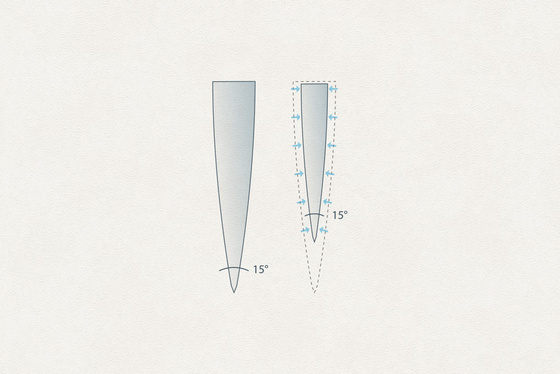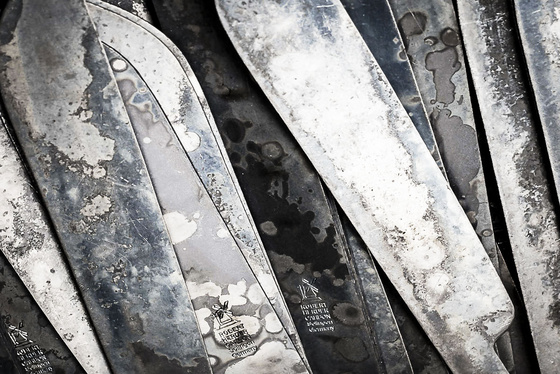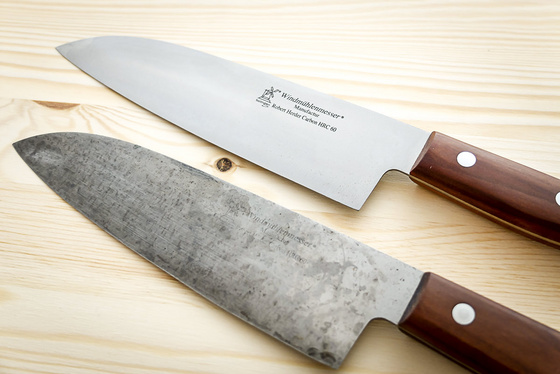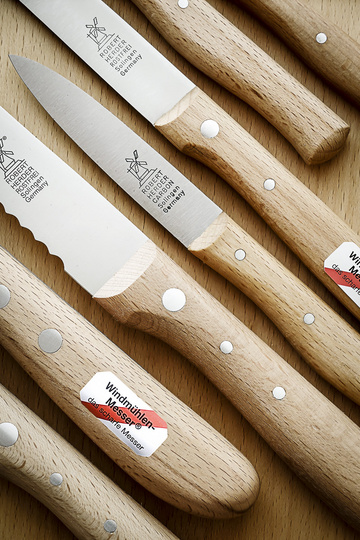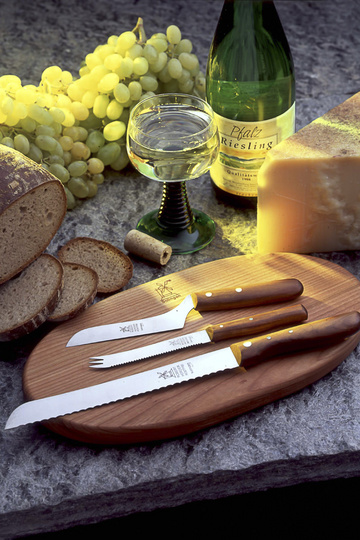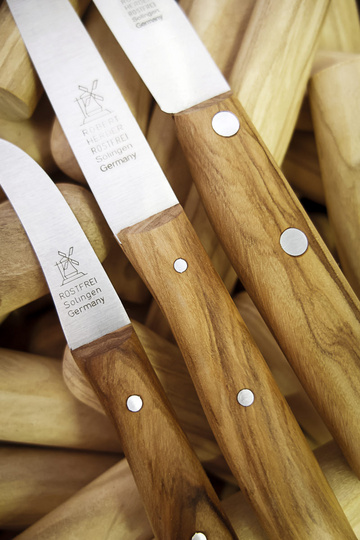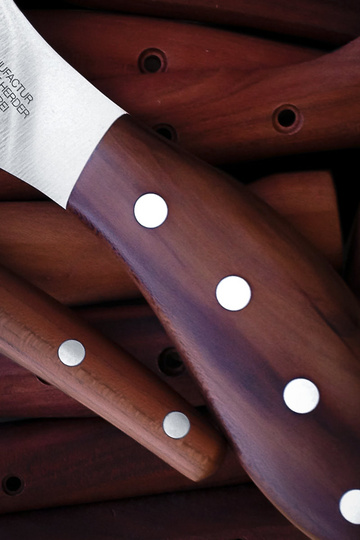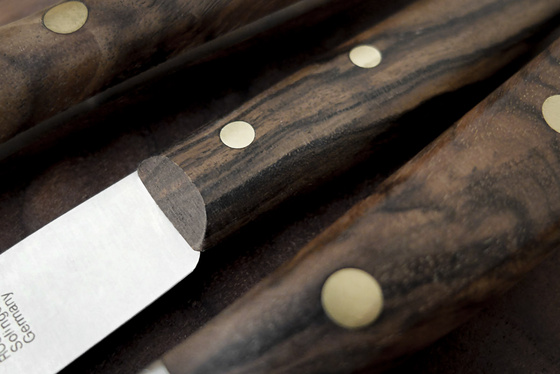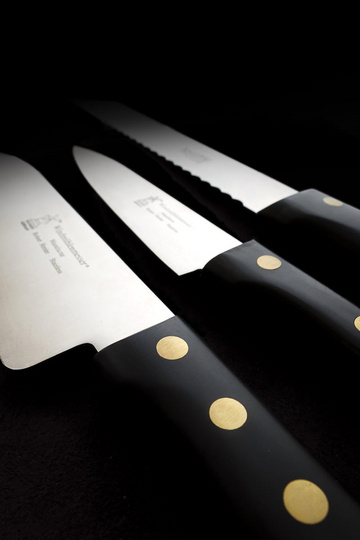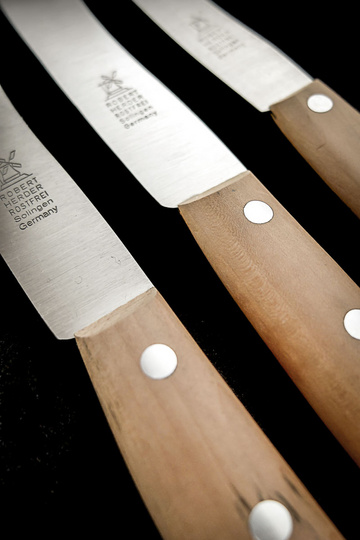One of the main features of our program are knives with blades made of non-stainless carbon steel. Carbon steel blades have existed since time immemorial, long before the invention of stainless steel – often known as rustproof steel. Stainless steel blades are characterised by the addition of chrome (some 14%) – which makes them rustproof – and their lower carbon content.
Product knowledge – Materials

What is better? – “non-stainless” or “stainless”
In Europe, stainless steel knives have meanwhile almost completely replaced carbon steel knives although the latter are ultimately much better suited for cutting. Their higher carbon content (over 0.8%) means they can be tempered to a greater hardness and therefore ground thinner and sharper. This is why we mainly use carbon steel for our vegetable knives.
A disadvantage of carbon steel knives however is their corrodibility which develops when they come into contact with liquids and lactid and fruit acids, producing a resultant metallic taste. Care is also needed with lemons, tomatoes, peppers, cheese or pickles. Stainless steel knives are interesting if used as table cutlery where a beautiful, clean appearance is all-important. This is why we prefer stainless material for e.g. breakfast knives, bread knives, cheese and salami knives, tomato or filleting knives for ham or salmon.
Carbon steel
Its special properties including hardness, sharpness and long-lasting cutting ability is still hard to find in stainless steels of comparable characteristics. This kind of steel is non-stainless and gains its greyish patina after the first cut. This is the oxidation colour that occurs by being in contact with water or vegetable and fruit juices and their natural acids. This is normal and completlely harmless.
A bit of iron releases from the blade while cutting, just microfine particles. It is caused by the micro-corrosion process which leads to a continuous and equal abrasion of the whole blade. The blade becomes thinner and thinner but keeps its original thin grinding degree of 15°. This is the reason for the long-lasting and non-decreasing sharpness (see illustration). The transfer of iron particles could cause the cut foodstuffs to have a slight metallic taste but this is harmless and immediately disappears during cooking.
Copper Beech
Our copper beech wood from Germany has always been high quality and very resistant.
Due to the natural, uneven tree growth, which is dependent on the location, brightness and age of the beech trees, the handles vary slightly in colour and grain. If we are lucky enough to get wood from the inner core of the trunk, the so-called red heartwood, this results in handles with beautiful dark veins that run through the otherwise rather calm grain of this wood.
As is usual for us, we also do not use any varnishes or stains for the beech handles. The wood is steamed with hot steam for better durability and then only processed with natural oils and pastes. In this way, the wooden surface is not sealed, but remains open-pored and can breathe.
After the first contact with water it roughens somewhat. This feature makes it slip-proof and therefore safe when cutting.
Cherry wood
In Germany cherry wood has always been considered a proven and exquisite wood for high-quality knife handles. Since the introduction of industrial production and plastics, it has to a large extent disappeared.
Our cherry wood handles are hand-ground by our masters, freeformed and finely polished. They stand out for their comfortably warm feel, their natural grip and beautiful texture.
Due to its particularly dense and hard structure we preferably use cherry wood from northern slopes of german and austrian forests.
Our cutting boards are crafted in the same way as our handles - out of solid wood. Combined with our knives they perform a classic and elegant table culture. We do not use any chemical sealers to keep our knife handles and boards natural and food-safe.
Olive wood
[Translate to Englisch:] Der Olivenbaum gilt im Mittelmeerraum als der König aller Bäume. Mit seinen gut 6000 Jahren Geschichte und dem sonnig goldenen Öl seiner Früchte ist er heute auch bei uns in Mitteleuropa zum Inbegriff kulinarischer Lebensart geworden.
In Mediterranean countries, the olive tree is considered to be the most majestic of trees. Its 6000 year history and the golden yellow oil produced by its fruit have become the epitome of our Central European culinary lifestyle today.
The knife handles like their blades are ground into their diverse shapes with accomplished skill, fitted and matted. The different and always individual grain of the olive wood – which has been stored for many years – gives each knife its unique character.
Plum wood
The plum belongs to the Rosaceae family of botanical plants, which is native both to Europe and Asia Minor.
Its wood is hard, knotty and often interspersed with branches. The branch areas especially are characterised by particularly beautiful colouring. We call knives with handles made of these pieces “Plum Select”.
The wood of the plum is stronger and harder than that of the cherry. It grows very densely, with great resilience and is resistant to contact with water.
It therefore withstands use in the kitchen very well. Due to these excellent properties, it is very well suited as handle wood.
Its beautiful, nuanced colour texture ranges from light brown-rose to dark brown-violet.
A wood of exceptional character, beauty and high practical value.
Walnut wood
The wood for our walnut handles is taken from the root or the trunk close to the root. The wood comes from Baden and France.
It is hard and has a good grip, elegant blackish-brown coloring and a beautiful swirling grain. Rare, noble and very durable, it is a real treasure among the European woods.
POM-Plastics
Polyoxymethylene is a high-molecular-weight, thermoplastic, processable plastic of high strength and resistance. It was discovered in the 1920s, synthesized by DuPont in 1952 and its manufacture patented in 1956.
Its high stability, dimensional stability and soft grip make it a very good material for knife handles. It is temperature-resistant from -40°C to +175°C, so it can withstand a spell in a cold store or on a hot stove.
Robinia wood
Originally from the north east of the USA, robinia has been grown in Europe since 1635 and is now considered among its native species. It is most commonly found in Hungary and Southern Europe, but it is also cultivated in Australia, Western and East Asia, and North Africa. The trees have a very long life, reaching anything up to 100 years of age, and can grow to over 12 m in height.
Robinia is also commonly known by the name of false acacia, although botanically the two are unrelated. It is a species of the Fabaceae or legume family, as its podlike seed capsules suggest.
Robinia is one of the toughest, most durable and most valuable varieties of wood. It is very hard, has good workability, and is highly resistant to moisture and emissions.
Pear wood
Pear wood, like plum and apple, belongs to the Rosaceae family of plants. It is resistant and dense, has high dimensional stability and is durable, which means that it has good workability.
The wood is only slightly grained and is therefore often overlooked in favor of species with a stronger grain like olive or cherry – wrongly so, because the functional benefits of pear wood are undisputed. It is soft to the touch and sits comfortably in the hand.
